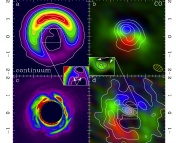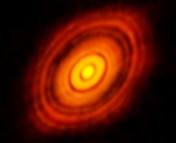Title: Kinematics of the CO Gas in the Inner Regions of the TW Hya Disk
Authors: Rosenfeld, Katherine A.; Qi, Chunhua; Andrews, Sean M.; Wilner, David J.; Corder, Stuartt A.; Dullemond, C. P.; Lin, Shin-Yi; Hughes, A. M.; D’Alessio, Paola; Ho, P. T. P.
First author’s institution: Harvard-Smithsonian Center for Astrophysics
The general “picture” of star formation includes a collapsing cloud of molecular gas, which forms a compact, flattened disk through which the gas can conglomerate into a star at the center. Amid all of the swirling chaos, the universe finds a way to order its diffuse gas into shining young stars. In the process, the behavior of the disk can be fairly simply described by a Keplerian pattern of rotation, where gas at a given radius, r, from the center moves with a velocity proportional to the inverse square root of the radius, as in v=(GM/r)0.5 (Anna provides a great explanation in her astrobite). That’s it, in theory.
But, the team of astronomers responsible for today’s paper have observed that in the case of one well-known disk, TW Hya (for more on disks, see this astrobite about AU Mic), some of the gas is moving faster than expected, and they set out to explain what they observed. The authors chose to observe TW Hya because it is relatively nearby at “just” 54 parsecs away, and nearly face-on. “Face-on” is the orientation where you would see a frisbee as a circle, as in the picture of HD141569 below, rather than a thin slice. With this orientation, the observations can tell a lot about the inclination of the source and test the simple rotation pattern explained above.
The observations:
Observations were made in 2011 during the construction phase of the Atacama Large Millimeter/Sub-mm Array (ALMA) in northern Chile, set to be completed next year. At the time, the array included nine of its eventual fifty-four 12-m antennas, and none of its eventual twelve 7-m antennas. The antennas were arranged in a relatively compact configuration, with the distance between any two antennas ranging between about 20 and 100 meters. An incredible fact is that at the time, ALMA was already one of the most powerful observatories of its kind, and growing.
Typically, ALMA observations are determined based on a competitive, international proposal process that occurs approximately once per year, but the observations for today’s paper were slightly different. In addition to the annual call for proposals, throughout the effort known as “Commissioning and Science Verification” at ALMA, astronomers are invited to suggest observations which will test and demonstrate the capabilities of ALMA. What sets apart Science Verification observations are that the data are made public, and ALMA astronomers create guides on how to reduce the data, so that astronomers world wide can explore and perfect the techniques necessary to analyze ALMA data. Yes, that’s right, you too can go take a look at the data from today’s paper and a variety of other observations here! In fact, the author of this paper, a graduate student herself, recommends Science Verification data, and the guides that accompany them, as excellent resources for students.
These Science Verification observations of TW Hya included two carbon monoxide (CO) rotational transitions, one at 230.5 GHz and the other at 345.8 GHz (more about molecular transitions in this astrobite). The observations can tell details in the disk that have sizes of about 100 AU. However, the authors make the well-motivated assumption that extremely doppler shifted CO emission comes from a small region of about 5 AU in the inner area of the proto-stellar disk. This CO emission probes the action at the very center of the disk, gas crucial in the star forming process.
For these transitions of CO, the intensity of emission that is detected depends on the product of the gas temperature and the emitting area. Since CO emission comes from a small inner area of the proto-stellar disk, the detection is generally weak. The authors of this paper determine that the ALMA observations are more than 10 times more sensitive than previous views of CO emission from TW Hya, and with this superb sensitivity they find a surprising new feature of the emission: some of the emission is coming from CO gas within the disk that is traveling towards or away from us at velocities that differ by as much as 2 km/s from what is expected from simple Keplerian rotation (in which case all of the gas should be moving parallel along the disk, not towards or away from us).
How to explain what they see:
These highly sensitive observations offer a unique opportunity to test how well different disk models represent observations of the real thing. The qualitative comparison between observations and models can be seen, for example, in this figure:

Comparison of the observed disk (top row) and models of disks (other rows), varying several parameters to find which model best matches the observations. The panels within a row are called channel maps, and they show emission at different frequencies, which correspond to gas moving at different velocities. The numbers at the bottom indicate these velocities with respect to the intrinsic disk velocity. The "novel" features observed here are the emission at velocities up to about 2 km/s from the disk, seen in the far left and right panels.
The authors first compared the observations with a model which is called the “fiducial model”, using parameters such as density, radius, temperature, mass, and standard Keplerian rotation that have been motivated in previous studies. When compared with the ALMA observations, the basic model fails to recreate the full spread of velocities that are observed. The hunt is on for another model, and the authors test three alternatives:
(1) A disk that is much hotter in the inner part than in the outer, by about a factor of three.
(2) Modified rotational velocities, so that gas in the inner disk moves faster than predicted by Keplerian rotation. The authors state that this is the least physically-motivated alternative.
(3) A warped disk, so that the inclination of the disk increases towards the center, and hence the “faster-than-Keplerian-rotation” that is observed may be explained as a projection effect.
Conclusions:
The authors suggest that the explanation is likely a combination of the different models they explored, and they humbly admit that other possible factors have yet to be explored. The goal of the paper was to demonstrate concepts that would verify the observations of gas moving faster than predicted by Keplerian rotation, which the authors call a “novel” feature first seen with high-sensitivity ALMA observations. With higher resolution observations, coming in the near future with ALMA, more information about emission coming from the inner 5 AU region will be available, and more comparisons among observations and models will be possible.






Trackbacks/Pingbacks